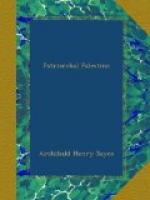The language of Canaan was practically that which we call Hebrew. Indeed Isaiah (xix. 18) speaks of the two dialects as identical, and the so-called Phoenician inscriptions that have been preserved to us show that the differences between them were hardly appreciable. There were differences, however; the Hebrew definite article, for instance, is not found in the Phoenician texts. But the differences are dialectal only, like the differences which the discovery of the Moabite Stone has shown to have existed between the languages of Moab and Israel.
How the Israelites came to adopt “the language of Canaan” is a question into which we cannot here enter. There have been other examples of conquerors who have abandoned the language of their forefathers and adopted that of the conquered people. And it must be remembered, on the one hand, that the ancestors of Israel had lived in Canaan, where they would have learnt the language of the country, and, on the other hand, that their original tongue was itself a Semitic form of speech, as closely related to Hebrew as French or Spanish is to Italian.
The Tel el-Amarna tablets have told us something about the language of Canaan as it was spoken before the days when the Israelites entered the land. Some of the letters that were sent from Palestine contain the Canaanite equivalents of certain Babylonian words that occur in them. Like the Babylonian words, they are written in cuneiform characters, and since these denote syllables and not mere letters we know exactly how the words were pronounced. It is an advantage which is denied us by the Phoenician alphabet, whether in the inscriptions of Phoenicia or in the pages of the Old Testament, and we can thus obtain a better idea of the pronunciation of the Canaanitish language in the century before the Exodus than we can of the Hebrew language in the age of Hezekiah.




